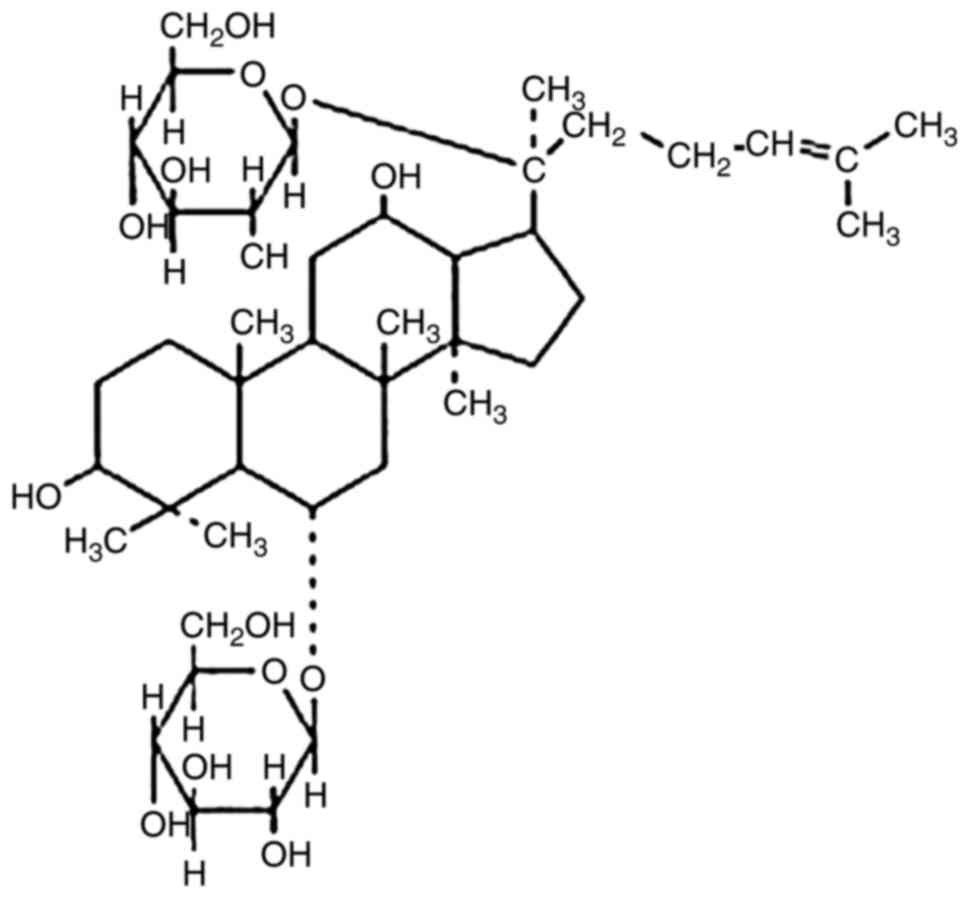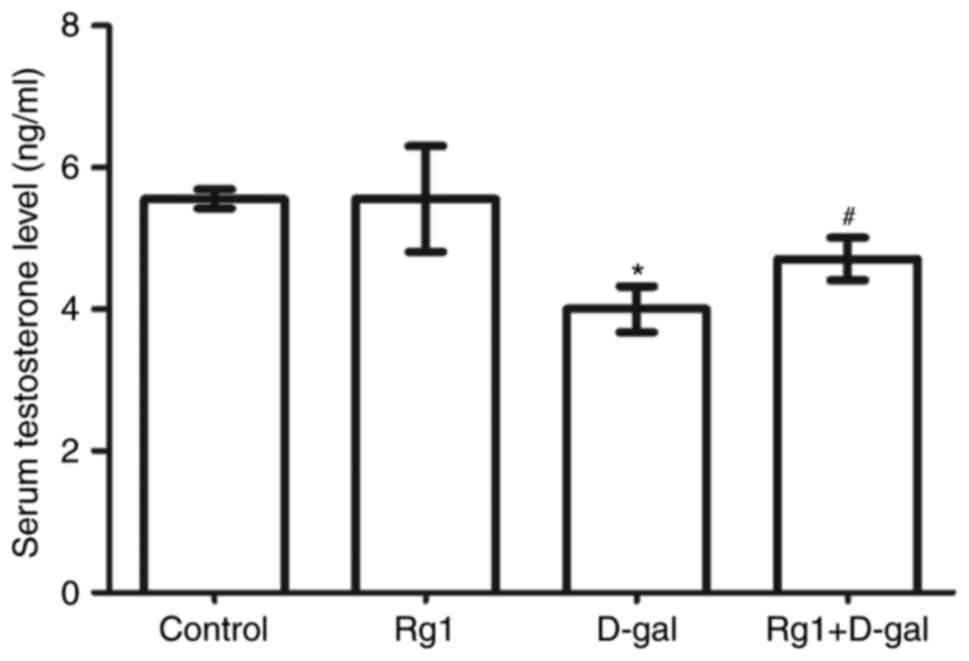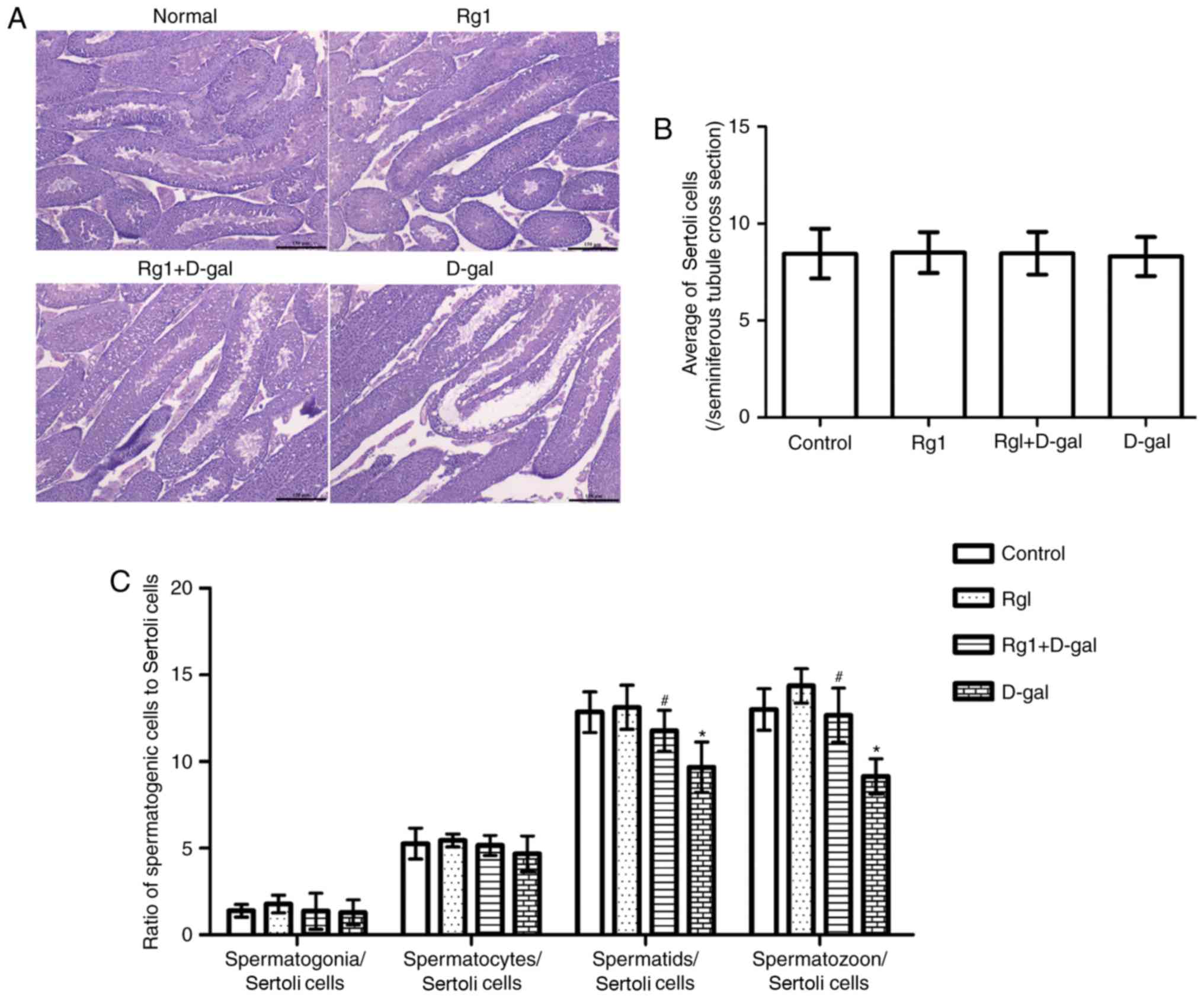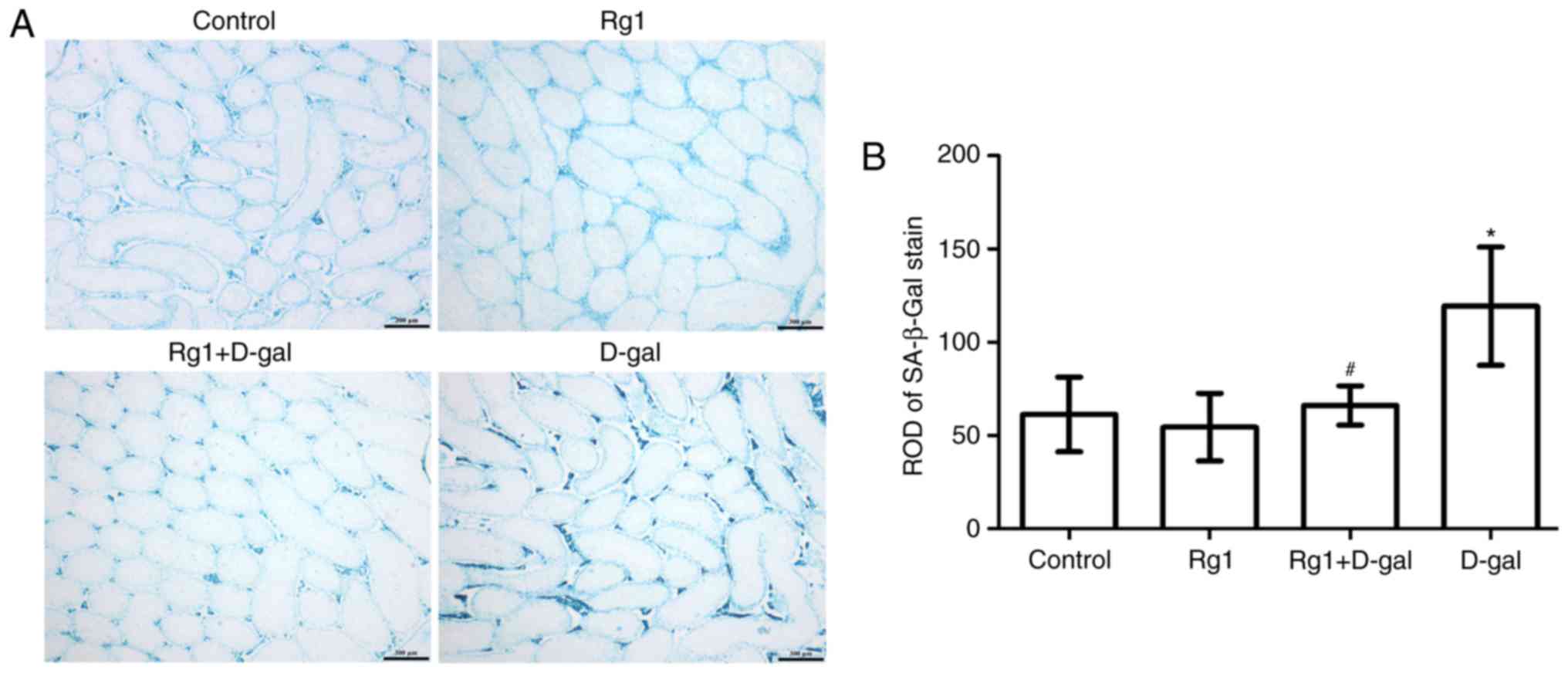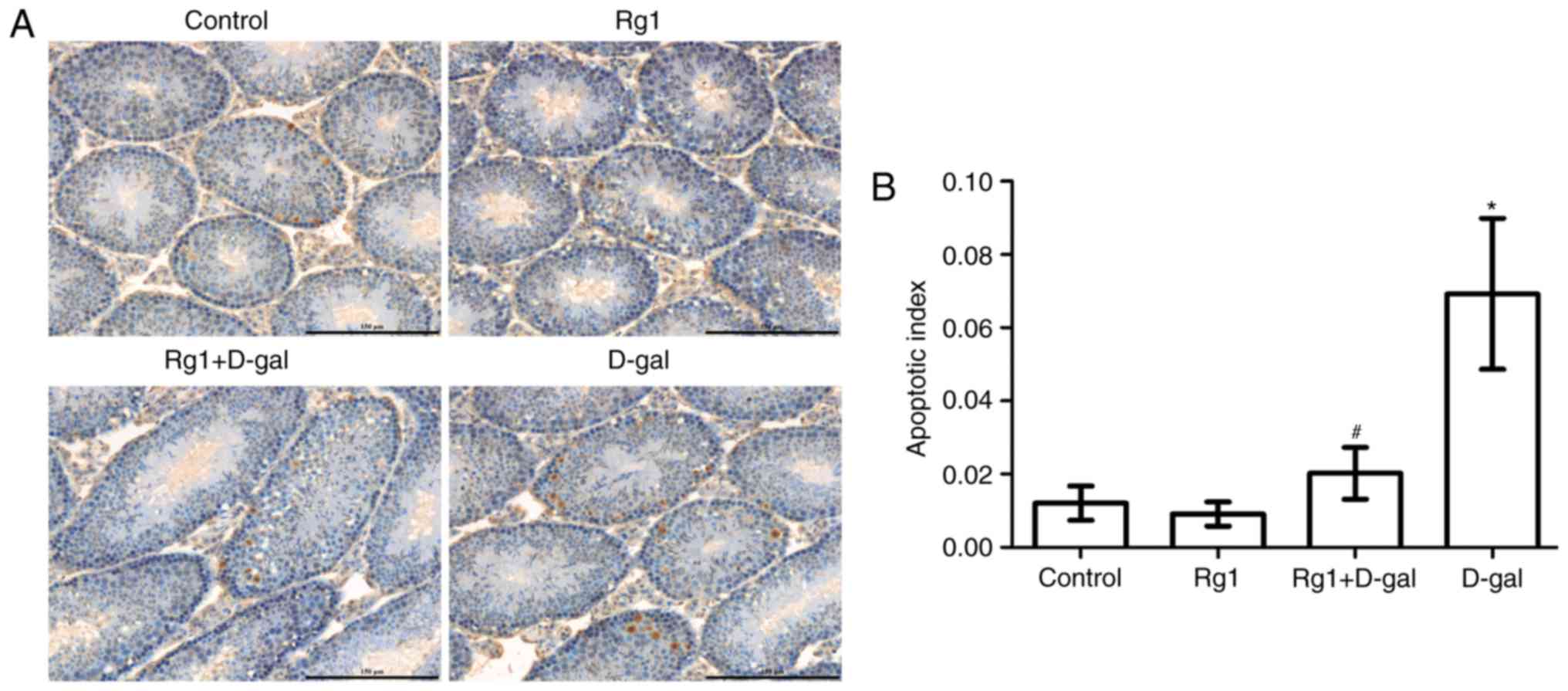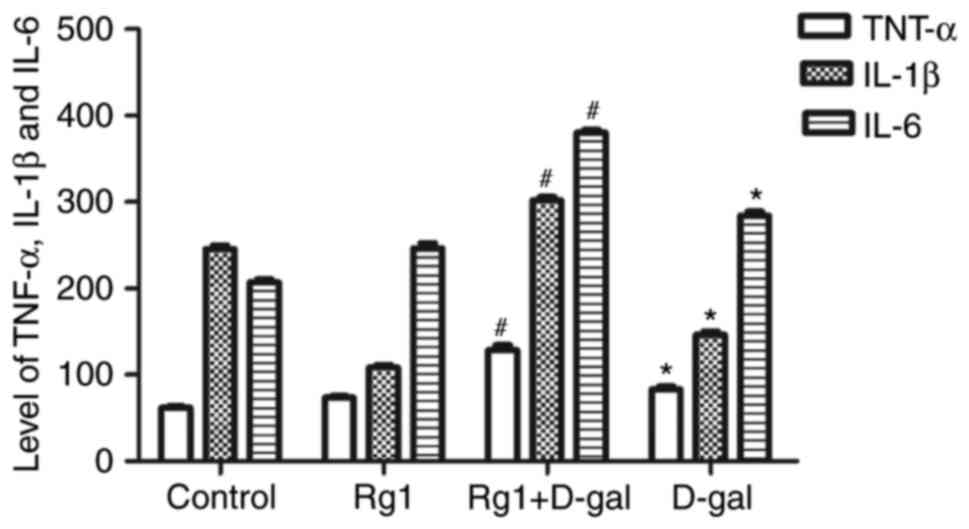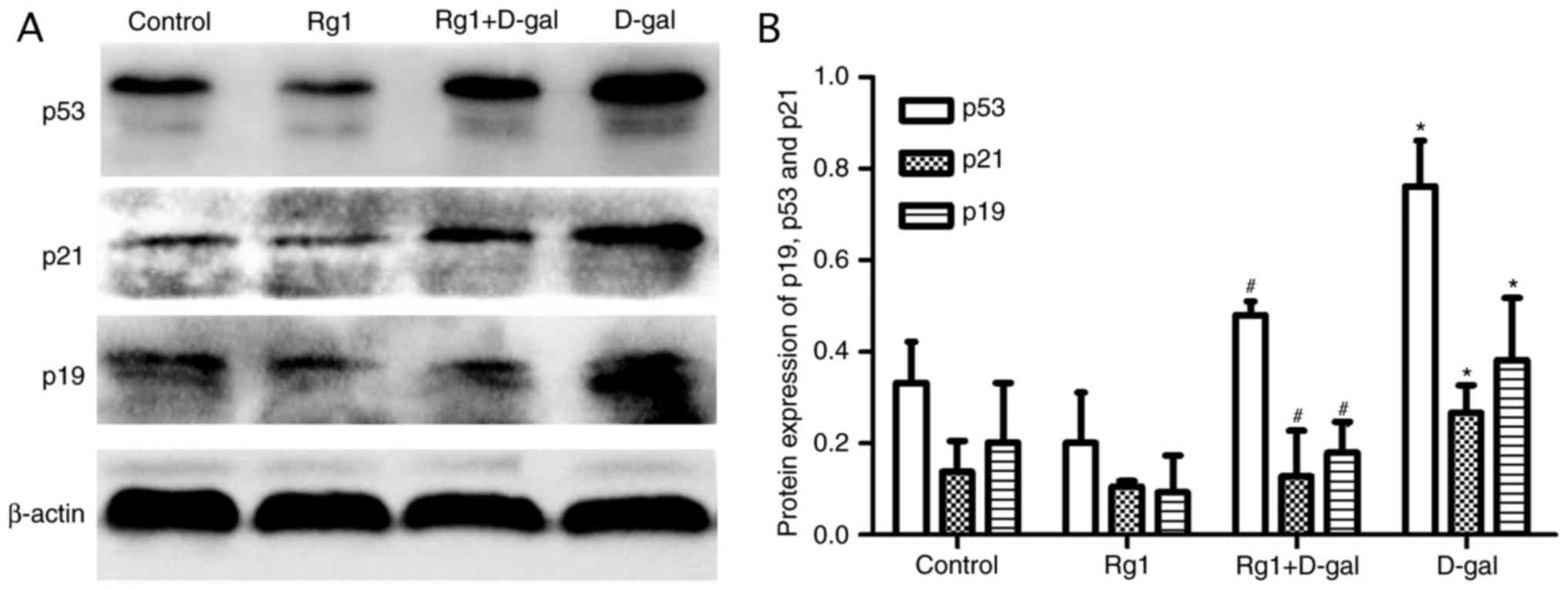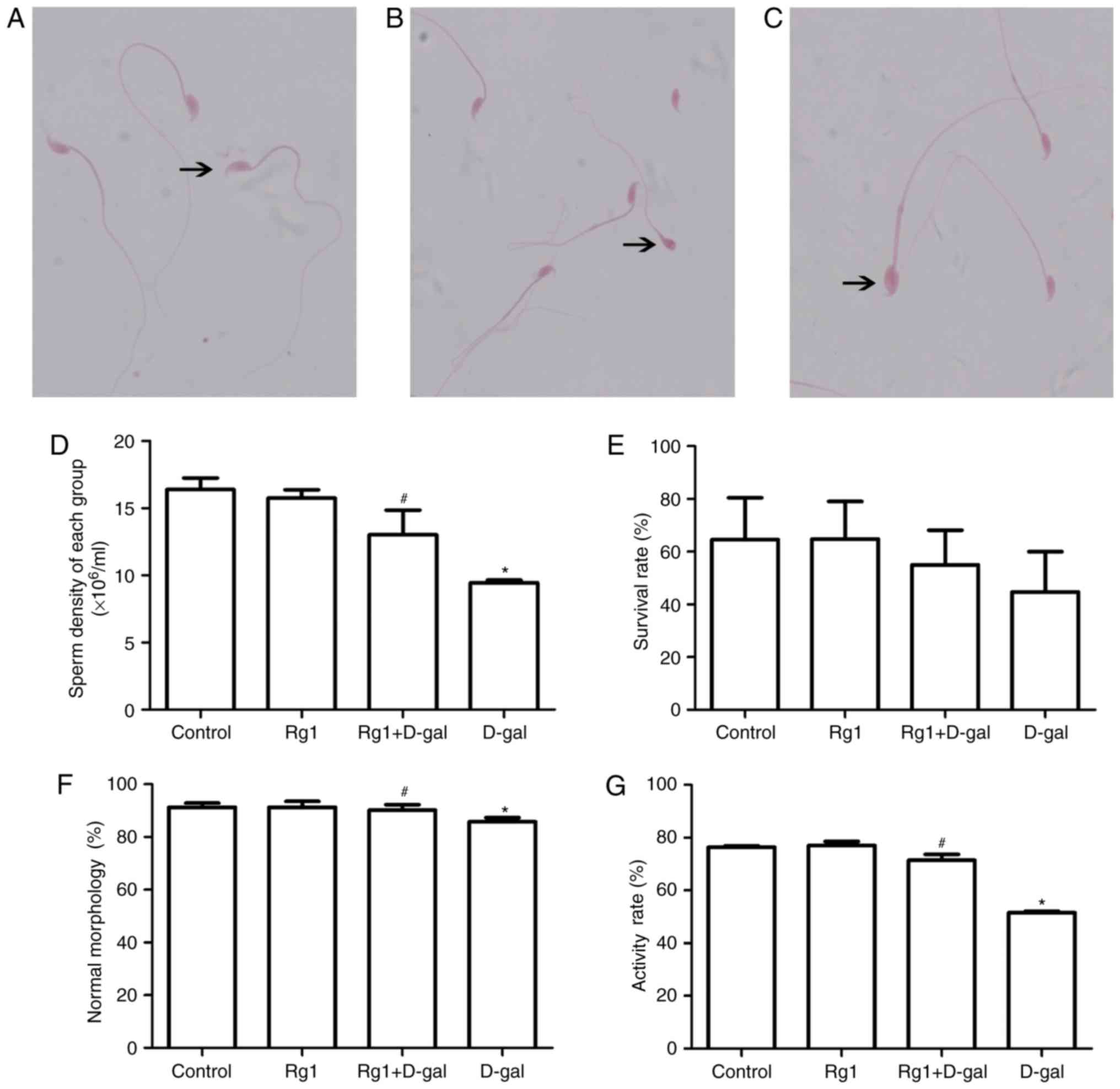Ginsenoside Rg1 ameliorates testicular senescence changes in D‑gal‑induced aging mice via anti‑inflammatory and antioxidative mechanisms
- Authors:
- Published online on: March 1, 2018 https://doi.org/10.3892/mmr.2018.8659
- Pages: 6269-6276
-
Copyright: © Wang et al. This is an open access article distributed under the terms of Creative Commons Attribution License.
Abstract
Introduction
Aging is the universal and gradual process of recession of all bodily organs. It has been reported that the decline of male physiological and sexual functions is associated with aging of the male reproductive system (1). The testes are a vital organ of the male reproductive system, and have the ability to synthesize/excrete testosterone and produce sperm (spermatogenesis). Therefore, it is important to delay the aging of the testes in order to improve the physiological and sexual function in elderly men.
It has been reported that natural aging may be modeled by D-galactose (D-gal) in vitro and in vivo (2–4). D-gal has been widely used to generate an aging model. The D-gal-induced model is regarded as the ideal model to investigate the process of aging, and to assay potential compounds for their effects against organismal aging. Ginseng is a tonic drug in traditional Chinese medicine. Ginsenoside Rg1 is a principal anti-aging active ingredient of ginseng. Previous studies (2–5) have revealed that ginsenoside Rg1 may defer the senescence of stem cells, and protect the immune organs, hemopoietic organs and brain from D-gal-induced aging via antioxidant and anti-inflammatory mechanisms. However, the effects of ginsenoside Rg1 on the testes in D-gal-induced mice have not been reported.
In recent decades (6,7), a variety of aging associated molecules and their corresponding signal pathway was determined. The p19-p53-p21 pathway has been considered to be an important regulatory pathway associated with cellular senescence (8). Our previous study demonstrated that the oxidative stress response to senescence in D-gal-induced mice activated the p19-p53-p21 pathway (2,4,5). Furthermore, p53, p21 and p19 proteins have also been suggested to be associated with cellular senescence, and their expression can be used as a measure of the degree of cellular senescence (2–5).
In the present study, testicular aging was established to observe the alterations in testicular microstructure and function in vivo in D-gal-induced mice. The protective effect of ginsenoside Rg1 was investigated. In addition, the preliminary underlying mechanism was explored. The present study aimed to identify a drug to delay the decline of the males reproductive system by attenuating the retrogression of testicular function.
Materials and methods
Animals
6-8-week old male C57BL/6 mice (20–25 g) were purchased from the Medical and Laboratory Animal Center of Chongqing (no. SCXK yu. 2012-0001), and housed in specific pathogen free conditions at a temperature of 20–25°C, a 50–70% humidity, a light/dark cycle of 12/12 h, and with free access to water and food. All procedures complied with the guiding principles for the care and use of animals and were approved by the Committee on Ethics of Animal Experimentation at Chongqing Medical University (Chongqing, China). The 60 mice were divided into four groups at random (control, Rg1, Rg1 + D-gal and D-gal). In the D-gal group, D-gal (120 mg/kg/day) was injected subcutaneously into the mice daily for 42 days. In the D-gal + Rg1 group, Rg1 (20 mg/kg/day) was injected intraperitoneally concomitantly for 28 days, from day 15 of the D-gal injections. In the control group, saline was given in the same volume subcutaneously and intraperitoneally, respectively. In the Rg1 group, saline at the same volume as the D-gal injection was injected subcutaneously for 42 days, and Rg1 (20 mg/kg/day) was injected intraperitoneally for 28 days from day 15 of saline injection. On the 43rd day, the mice were sacrificed by cervical dislocation.
Reagents
Ginsenoside Rg1 (cat. no. RSZD-121106; purity, 98.3%) was purchased from Xi'an Haoxuan Bio-Tech Co., Ltd. (Xi'an, China) (Fig. 1), dissolved in PBS at a concentration of 20 mg/ml, and sterilized by ultrafiltration. D-gal (purity, >99%) was acquired from Shanghai Bioengineering Co., Ltd. (Shanghai, China). The superoxide dismutase (SOD) kit, methane dicarboxylic aldehyde (MDA) kit, total antioxidant capacity (TAC) kit, primary antibody dilution buffer and goat anti-rabbit (cat. no. A0208) and goat anti-mouse (cat. no. A0216) secondary antibodies were obtained from Beyotime Institute of Biotechnology (Haimen, China). The interleukin (IL)-1β kit (cat. no. EMC001B), IL-6 kit (cat. no. EMC004) and tumor necrosis factor (TNF)-α kit (cat. no. EMC102a) were purchased from Neobioscience Co., Ltd. (Shenzhen, China). The senescence-associated β-galactosidase (SA-β-gal) staining kit was purchased from Cell Signaling Technology, Inc. (Danvers, MA, USA). The terminal deoxynucleotidyl transferase (TdT) dUTP nick end labeling (TUNEL) Apoptosis Assay kit was purchased from Jiamay Biotech (Beijing, China). Anti-S-phase kinase-associated protein (p19) rabbit polyclonal (cat. no. 10272-2-AP), anti-cellular tumor antigen p53 (p53) and anti-cyclin-dependent kinase inhibitoru 1 (p21) mouse monoclonal antibodies (cat. nos. 10442-1-AP and 60214-1-Ig) were obtained from ProteinTech Group, Inc. (Chicago, IL, USA).
Assessment of testosterone in the serum
Mouse serum obtained from the angular vein was centrifuged (3,000 × g, 10 min, 4°C). The level of serum testosterone was analyzed using an automatic biochemical analyzer (cat. no. DXI800; Beckman Coulter, Inc., Brea, CA, USA).
Analysis of testis index and structure
Testis index was calculated using the equation testis index=testes weight (mg)/body weight (g), and the testes was stored in a solution of 4% paraformaldehyde (pH 7.4) for 24 h at 4°C, dehydrated in graded (50–100%) alcohol and embedded in paraffin. Sections (5–8 µm) were cut and stained with hematoxylin and eosin (hematoxylin staining for 5 min at room temperature; eosin staining for 3 min at room temperature). The pathological structure of the testes and the differential counts of spermatogenetic cells were measured using a microscope image analysis system (Olympus Corporation, Tokyo, Japan) (9).
Detection of senescence and apoptosis of spermatogenetic cells
The SA-β-gal staining and apoptosis detection were performed according to the manufacturers' protocols. Frozen sections (10-µm; −25°C) of mouse testis tissue were prepared for SA-β-gal staining. Senescent cells appeared blue under light microscopy (magnification ×40). Paraffin-embedded sections (4-µm) were prepared for TUNEL staining. The pre-processing included dewaxing, anhydration and antigen retrieval and blocking using normal goat serum for 30 min to prevent nonspecific staining. Antigen retrieval was performed by immersing sections in citrate buffer and then heating the sections for 15 min at 90°C. Following cooling, the sections were washed three times in PBS and then immersed in 3% hydrogen peroxide for 15 min at room temperature. Following this, the sections were again washed using PBS. The sections were stained with TUNEL Staining Solution (solution A: solution B, 1:9) for 60 min at room temperature. The sections were color-developed with diaminobenzidine and the nuclei were stained with hematoxylin for 5 min at room temperature. At least three different fields of vision per section and per animal were observed and analyzed with Image Pro Plus 6.0 software (Media Cybernetics Inc., Rockville, MD, USA).
Measurement of oxidation-associated biomarkers and inflammatory cytokines
The testes of each mouse were weighed and homogenized with cold saline, and centrifuged (10,000 × g, 4°C, 20 min) to obtain the supernatant for further experiments. The SOD activity, MDA content and TAC were evaluated by chemical colorimetric analysis, according to the manufacturer's protocols. The levels of inflammatory cytokines (IL-1β, IL-6 and TNF-α) in each group were measured by ELISA analysis, according to the manufacturer's protocol.
Senescence-associated protein analysis
Tissue homogenate in each group was prepared as described above. The total protein was extracted using radioimmunoprecipitation assay lysis buffer mixed 1% protease inhibitor cocktail (Beyotime Institute of Biotechnology), and the concentration was measured by a bichinchoninic acid assay. Samples containing 40 µg proteins were separated via 12% SDS-PAGE and transferred to polyvinylidene fluoride membranes. The membranes were blocked using skimmed milk powder (5%, dissolved in TBS-Tween 20) for 2 h at room temperature, and the membranes were then incubated overnight at 4°C with anti-p53, anti-p21 and anti-p19 antibodies (1:1,000 diluted in primary antibody dilution buffer). The membranes were then incubated with secondary antibodies (1:800 diluted in TBS-Tween 20) for 90 min at room temperature. The membranes were visualized using an enhanced chemiluminescence detection system (Pierce; Thermo Fisher Scientific, Inc., Waltham, MA, USA). β-actin (1:1,000 diluted in antibody dilution buffer) was used as an internal control. Integral optical density was quantified using Image Lab 5.2.1 (Bio Rad Laboratories, Inc., Hercules, CA, USA).
Measurement of variation in semen parameters
Sperm was collected from the cauda epididymis and vas deferens. The epididymis was dissected in PBS and incubated for 10 min in a constant temperature incubator (37°C, 5% CO2) to allow the sperm to be released. A total of 10 µl diluted sperm from each group was placed in a counting chamber under a light microscope to determine the sperm density and survival rate (10). A total of 5 µl diluted sperm from each group was mixed with 5 µl eosin on microslides for 30 sec at room temperature, and a microscope (×200) was then used to investigate sperm viability (dead sperm appeared red). A total of 10 µl sperm was used to produce the smears. Sperm smears were dried at room temperature, stained with crystal violet (cat. no. C0121; Beyotime Institute of Biotechnology) for 1–3 min and washed using water for 3–5 min. The sperm morphology of each group was then determined.
Statistical analysis
All data are presented as mean ± standard deviation. All statistical analyses were performed using one-way analysis of variance followed by the Fisher's least significant difference test with SPSS v20.0 (IBM Corp., Armonk, NY, USA). P<0.05 was considered to indicate a statistically significant difference.
Results
Rg1 affects the general condition of D-gal-induced aging mice
Following the injection of D-gal, the mice developed withered and caducous hair, decreased skin elasticity, listlessness, a tendency to cluster together in groups, decreased food intake, and decreased activity and responsiveness. The control group, Rg1 group and Rg1 + D-gal group exhibited none of these signs. There were no complications detected in any of the mice. In previous studies, complications were not identified in other organs (4,5,11,12).
Rg1 affects the serum testosterone level in D-gal-induced aging mice
Testosterone is one of the steroid hormones produced primarily by Leydig cells in the testes. Testosterone is responsible for the development of the male reproductive system and is involved in the maintenance of male secondary sexual characteristics. Serum testosterone levels have observed to decline gradually with the aging process (13,14). The results of the present study (Fig. 2) demonstrated that the level of serum testosterone was significantly decreased in the D-gal-induced group. Following treatment with Rg1, the level of serum testosterone significantly increased compared with D-gal-induced group. This result demonstrated that Rg1 was able to significantly improve the ability of Leydig cells to secrete testosterone in D-gal-induced aging mice.
Rg1 affects the index and microscopic structure of testes
A previous study (9) reported that spermatogenetic malfunction may occur during the aging process. Classification and counting of spermatogenetic cells is of diagnostic importance for spermatogenetic malfunction. Tissue examination (Fig. 3A) demonstrated the integrity of the spermatogenetic epithelium and the regular arrangement of spermatogenetic cells in the control group. Compared with the control, structural abnormalities of the seminiferous tubule and a disordered arrangement of spermatogenetic was observed in the D-gal group. In the Rg1 + D-gal group, the pathological alteration of abnormal structure of the seminiferous tubule was not noted. No significant differences were observed in morphology or organ index among the four groups (D-Gal group, 0.0060±0.00081; Rg1 + D-Gal group, 0.0065±0.0012; Rg1 group, 0.0063±0.00037; and control group, 0.0064±0.00048). Subsequently, the differential counts of spermatogenetic cells were measured. The results (Fig. 3B and C) revealed that spermatogenetic cell/Sertoli cell number was decreased in the D-gal group, and increased following treatment with Rg1.
Rg1 affects SA-β-Gal staining in the testes of aged mice
SA-β-gal is a widely-used biomarker for aging cells. By adjusting to pH 6, blue molecules (Fig. 4A) may be visualized in the cytoplasm of the aging cell (2). The intensity of SA-β-gal staining was evaluated via the relative optical density (ROD) value of SA-β-gal-positive cells (Fig. 4A and B). The results demonstrated that the ROD value of the SA-β-gal staining was increased in the D-gal-induced group. By contrast, the ROD value of the SA-β-gal staining was decreased following treatment with Rg1 in the Rg1 + D-gal group. These results suggested that Rg1 may protect the testes against senescence.
Rg1 reduces spermatocyte apoptosis in aged mice
Previous studies have indicated that the degeneration of spermatogenesis is caused by apoptosis (15,16). TUNEL staining is a commonly used method, which has been proven to be useful for detecting DNA fragmentation resulting from apoptotic signaling cascades. TUNEL staining relies on the DNA ends that can be identified by TdT and the addition of dUTPs, which is a secondarily labeled marker catalyzed by an enzyme. In the present study, TUNEL was used to detect the level of spermatogenetic cellular apoptosis; positive cells displayed brown-yellow granules in the nucleus (Fig. 5A). Compared with the control group, positive cell number and the apoptotic index were increased in the D-gal group (P<0.05). The apoptotic index and the level of spermatocyte apoptosis were decreased following treatment with Rg1 (Fig. 5B).
Rg1 affects oxidation-associated biomarkers in aged mice
Oxidative stress is one of the causes of senescence. A previous study reported that the oxidation-reduction system may be damaged by aging (17). SOD is an enzyme that removes the free radicals generated by oxidative stress in aging. Thus, SOD activity is an important target for estimating antioxidant capacity. MDA may reflect the level of oxidative injury in the body, and level of MDA is an important target for estimating the level of oxidative damage. In the present study, the results demonstrated that SOD activity and TAC were decreased significantly, and MDA content was elevated significantly, in the D-gal group compared with the control. Conversely, in the Rg1 + D-gal group, SOD activity and TAC were significantly increased compared with the D-gal group. In addition, MDA content was decreased in the Rg1 + D-gal group (Table I). These results demonstrated that another factor of the protective effect of Rg1 on the testes may be an increase in the activity of SOD and a decreased in the oxidation product MDA.
Table I.Effect of Rg1 on the levels of SOD, MDA and TAC in the testes of D-gal-injected mice (mean ± standard deviation; n=14). |
Rg1 affects the levels of inflammatory cytokines in the testes of aged mice
Chronic inflammation is increased and the secretion of inflammatory cytokines is upregulated during the aging process. It has been reported that inflammatory cytokines, including TNF-α, IL-1β and IL-6, are increased during natural aging (18). The results of the present study demonstrated that the levels of TNF-α, IL-1β and IL-6 were significantly increased in the testes of the D-gal group. However, compared with the D-gal group, the levels of these three inflammatory cytokines were significantly decreased in the Rg1 + D-gal group (Fig. 6). These results indicated that the effect of D-gal on the levels of inflammatory cytokines may affect the aging of the testes, and that Rg1 was able to reduce the levels of these inflammatory cytokines.
Rg1 affects p19, p21 and p53 expression in the testes of aged mice
The p19/p53/p21 pathway serves an important role in aging. Following oxidative damage, the p19/p53/p21 pathway is activated and the expression of the proteins is upregulated (8). According to the western blot analysis in the present study, the levels of p19, p21 and p53 in the D-gal group were significantly increased compared with the control group. Following treatment with Rg1, the levels of these proteins were decreased significantly (Fig. 7). The results of the present study demonstrated that the p19/p53/p21 pathway was downregulated following treatment with Rg1.
Rg1 affects sperm parameters in the cauda epididymis and vas deferens in aged mice
One of the most common ways of tracking male fertility is semen analysis (10). Therefore, male reproductive status and spermatogenesis monitoring are of importance (Fig. 8). Sperm parameters, including sperm density, normal sperm morphology percentage and activity rate; are meaningful to monitor male reproductive function. In the present study, the sperm density (Fig. 8D), survival rate (Fig. 8E), normal sperm morphology percentage (Fig. 8F) and activity rate (Fig. 8G) were significantly decreased in the aging model. Following treatment with Rg1, sperm parameters improved significantly (Fig. 8). These results suggested that the reproductive function of aging males may be improved by treatment with Rg1.
Discussion
Aging is an unavoidable and complex biological process, which primarily refers to the alterations of biological structures and the degradation of functions resulting from a variety of factors (19–22). It has been reported that the normal 40–50-year old male may begin to exhibit reproductive functional decline, and that physiological function additionally declines, causing a negative impact on quality of life (23–25). The testes are an important part of the male reproductive system. The function of the testes broadly reflects the state of the male reproductive system (1,23). Therefore, it is of important to identify anti-aging drugs to delay the aging of the testes.
In the natural aging process, alterations in morphology and function may be observed in the male testes. In particular, testicular senescence manifests as testicular volume loss and a decrease in weight. In addition, the disordered arrangement of seminiferous tubules and spermatogenetic cells, and disturbances in spermatogenesis, have been investigated. The ability of the testes to secrete testosterone and sperm quality additionally decline (1). D-gal is the principal component of lactose, and lactose acts as a metabolite in glycometabolism. However, the excessive accumulation of D-gal causes metabolic disorders, eventually leading to aging (5,26). Previous studies (2,5,12) have demonstrated that ginsenoside Rg1 may protect against aging of the brain, liver, kidney and thymus. However, the effect of Rg1 on the testes remains unclear and the precise mechanism has not been elucidated. Therefore, in the present study, D-gal was used to generate an aging model to examine the role and mechanism of Rg1 in protecting the testes of aging mice. The results of the present study demonstrated that the classification and counting of spermatogenetic cells, including spermatocyte/supporting cells, spherical spermatid/supporting cells and long spermatid/supporting cells; were decreased in the D-gal group, which had been increased following treatment with Rg1. In the D-gal group, sperm survival rate, activity and normal sperm rate, and the level of serum testosterone were decreased significantly compared with the control group. Following treatment with Rg1, the improvements in sperm parameters and the level of serum testosterone were significant. By contrast, the alterations in weight and morphology in the D-gal and D-gal + Rg1 groups were not significant. These results indicated that D-gal is induced aging of testicular function, although it exerted no effect on weight and morphology. Rg1 was able to improve the function of the testes. The reasons for these results required further investigation. SA-β-gal staining is based on the upregulation of the level of SA-β-gal activity as a result of aging. Senescent cells with high enzymatic activity at pH 6.0 were stained blue. SA-β-gal staining has been used to detect normal cellular aging (2). Apoptosis serves an important role in maintaining testicular spermatogenetic function (16). TUNEL staining has been previously used to detect the apoptosis of spermatogenetic cells (16). In the present study, the absorbance of SA-β-gal-positive cells and the apoptosis index of spermatogenetic cells were increased in the D-gal group, and decreased following treatment with Rg1. These results further indicated that Rg1 was able to protect against D-gal-induced aging of the testes.
The free radical theory of aging states that the aging of an organism is frequently a consequence of the accumulation of cellular free radical damage over time (17). For the majority of biological structures, free radical damage is associated with oxidative damage. Under normal circumstances, oxidation and antioxidation are in a dynamic balance (17,20). MDA, as the end product of lipid oxidation, exerts a cytotoxic effect that increases with the degree of lipid oxidation, indicating that the level of MDA may be an important target to measure membrane lipid peroxidation. SOD is a type of antioxidant enzyme that may slow the process of aging by clearing free radicals (27). The activity of SOD reflects the antioxidant ability of an organism. In the present study, the activity of SOD and TAC in the D-gal-induced group was significantly decreased, and the MDA content was significantly increased. The results of the present study demonstrated that D-gal may lead to aging by causing oxidative damage. By contrast, following treatment with Rg1, the activity of SOD and TAC increased compared with the D-gal group, and MDA decreased. This protective effect may be associated with the antioxidant effect of Rg1.
Oxidative stress regulates and promotes the expression of the senescence-associated proteins p19, p53 and p21 (28–30). The activity of the tumor suppressor protein p53 is increased (31) and p53 induces p21 expression, which has an association with cell cycle arrest triggering cellular senescence (29). p19 is encoded by the INK4A locus, and is involved in the p53 pathway by inhibiting E3 ubiquitin-protein ligase Mdm2 activity (32). The increased expression of p19 is one mechanism through which p53 is activated (33). The results of the present study demonstrated that the reduction of p19, p21 and p53 protein were significant compared with the aging group. Therefore, it may be hypothesized that Rg1 may exert its protective effect against testicular senescence by downregulating the p19/p53/p21 pathway. The release of cell-associated inflammatory factors was observed in the present study. It has been previously demonstrated that these factors may lead to chronic inflammation of the body, which is the crux of the inflammatory aging theory (34,35). TNF-α, IL-1, IL-6 and other inflammatory factors may be used as serum markers of inflammatory senescence. The present study demonstrated that the levels of TNF-α, IL-1 and IL-6 in testicular tissues were significantly decreased following treatment with Rg1, which may be the underlying mechanism of the anti-aging effect of Rg1.
In conclusion, the present study examined the protective effect of Rg1 on D-gal-induced testicular aging, and it was determined that the underlying mechanism of Rg1 anti-aging in the testes of D-gal mice is antioxidant and anti-inflammatory. It is of importance to identify drugs that protect against the effects of aging on male reproductive function.
Acknowledgements
The present study was supported by grants from the National Natural Science Foundation of China (grant nos. 30973818 and 81673748).
References
|
Gunes S, Hekim GN, Arslan MA and Asci R: Effects of aging on the male reproductive system. J Assist Reprod Genet. 33:441–454. 2016. View Article : Google Scholar : PubMed/NCBI | |
|
Hu W, Jing P, Wang L, Zhang Y, Yong J and Wang Y: The positive effects of ginsenoside Rg1 upon the hematopoietic microenvironment in a D-galactose-induced aged rat model. BMC Complement Altern Med. 15:1192015. View Article : Google Scholar : PubMed/NCBI | |
|
Zhou Y, Liu J, Cai S, Liu D, Jiang R and Wang Y: Protective effects of ginsenoside Rg1 on aging Sca-1+ hematopoietic cells. Mol Med Rep. 12:3621–3628. 2015. View Article : Google Scholar : PubMed/NCBI | |
|
Li J, Cai D, Yao X, Zhang Y, Chen L, Jing P, Wang L and Wang Y: Protective effect of ginsenoside Rg1 on hematopoietic stem/progenitor cells through attenuating oxidative stress and the Wnt/β-catenin signaling pathway in a mouse model of d-galactose-induced aging. Int J Mol Sci. 17:2016. | |
|
Fan Y, Xia J, Jia D, Zhang M, Zhang Y, Huang G and Wang Y: Mechanism of ginsenoside Rg1 renal protection in a mouse model of d-galactose-induced subacute damage. Pharm Biol. 54:1815–1821. 2016. View Article : Google Scholar : PubMed/NCBI | |
|
DiLoreto R and Murphy CT: The cell biology of aging. Mol Biol Cell. 26:4524–4531. 2015. View Article : Google Scholar : PubMed/NCBI | |
|
Finkel T: The metabolic regulation of aging. Nat Med. 21:1416–1423. 2015. View Article : Google Scholar : PubMed/NCBI | |
|
Rodier F and Campisi J: Four faces of cellular senescence. J Cell Biol. 192:547–556. 2011. View Article : Google Scholar : PubMed/NCBI | |
|
Wright WW, Fiore C and Zirkin BR: The effect of aging on the seminiferous epithelium of the brown Norway rat. J Androl. 14:110–117. 1993.PubMed/NCBI | |
|
Cao XW, Lin K, Li CY and Yuan CW: A review of WHO laboratory manual for the examination and processing of human semen (5th edition). Zhonghua Nan Ke Xue. 17:1059–1063. 2011.(In Chinese). PubMed/NCBI | |
|
Dong Z, Xu M, Huang J, Chen L, Xia J, Chen X, Jiang R, Wang L and Wang Y: The protective effect of Ginsenoside Rg1 on aging mouse pancreas damage induced by D-galactose. Exp Ther Med. 14:616–622. 2017. View Article : Google Scholar : PubMed/NCBI | |
|
Xia JY, Fan YL, Jia DY, Zhang YY, Li J, Jing PW, Wang L and Wang YP: Protective effect of Angelica sinensis polysaccharide against liver injury induced by D-galactose in aging mice and its mechanisms. Zhonghua Gan Zang Bing Za Zhi. 24:214–219. 2016.(In Chinese). PubMed/NCBI | |
|
Golan R, Scovell JM and Ramasamy R: Age-related testosterone decline is due to waning of both testicular and hypothalamic-pituitary function. Aging Male. 18:201–204. 2015. View Article : Google Scholar : PubMed/NCBI | |
|
Russo SJ, Murrough JW, Han MH, Charney DS and Nestler EJ: Neurobiology of resilience. Nat Neurosci. 15:1475–1484. 2012. View Article : Google Scholar : PubMed/NCBI | |
|
Hsueh AJ, Eisenhauer K, Chun SY, Hsu SY and Billig H: Gonadal cell apoptosis. Recent Prog Horm Res. 51:433–456. 1996.PubMed/NCBI | |
|
Wang C, Sinha Hikim AP, Lue YH, Leung A, Baravarian S and Swerdloff RS: Reproductive aging in the Brown Norway rat is characterized by accelerated germ cell apoptosis and is not altered by luteinizing hormone replacement. J Androl. 20:509–518. 1999.PubMed/NCBI | |
|
Harman D: About ‘Origin and evolution of the free radical theory of aging: A brief personal history, 1954–2009’. Biogerontology. 10:7832009. View Article : Google Scholar : PubMed/NCBI | |
|
Brüünsgaard H and Pedersen BK: Age-related inflammatory cytokines and disease. Immunol Allergy Clin North Am. 23:15–39. 2003. View Article : Google Scholar : PubMed/NCBI | |
|
Young A: Ageing and physiological functions. Philos Trans R Soc Lond B Biol Sci. 352:1837–1843. 1997. View Article : Google Scholar : PubMed/NCBI | |
|
Yu BP and Chung HY: Adaptive mechanisms to oxidative stress during aging. Mech Ageing Dev. 127:436–443. 2006. View Article : Google Scholar : PubMed/NCBI | |
|
Everitt A and Meites J: Aging and anti-aging effects of hormones. J Gerontol. 44:B139–B147. 1989. View Article : Google Scholar : PubMed/NCBI | |
|
Sakamoto Y, Ichimura T, Tsuruzoe S and Nakao M: Aging and DNA methylation. Nihon Ronen Igakkai Zasshi. 42:137–143. 2005.(In Japanese). View Article : Google Scholar : PubMed/NCBI | |
|
Araujo AB, Mohr BA and McKinlay JB: Changes in sexual function in middle-aged and older men: Longitudinal data from the Massachusetts Male Aging Study. J Am Geriatr Soc. 52:1502–1509. 2004. View Article : Google Scholar : PubMed/NCBI | |
|
Brahem S, Mehdi M, Elghezal H and Saad A: The effects of male aging on semen quality, sperm DNA fragmentation and chromosomal abnormalities in an infertile population. J Assist Reprod Genet. 28:425–432. 2011. View Article : Google Scholar : PubMed/NCBI | |
|
Gray A, Feldman HA, McKinlay JB and Longcope C: Age, disease, and changing sex hormone levels in middle-aged men: Results of the massachusetts male aging study. J Clin Endocrinol Metab. 73:1016–1025. 1991. View Article : Google Scholar : PubMed/NCBI | |
|
Lu X, Zhou Y, Wu T and Hao L: Ameliorative effect of black rice anthocyanin on senescent mice induced by D-galactose. Food Funct. 5:2892–2897. 2014. View Article : Google Scholar : PubMed/NCBI | |
|
Van Raamsdonk JM and Hekimi S: Deletion of the mitochondrial superoxide dismutase sod-2 extends lifespan in Caenorhabditis elegans. PLoS Genet. 5:e10003612009. View Article : Google Scholar : PubMed/NCBI | |
|
Liang L, Zhang XH, Ji B, Yao H, Ling XM, Guo ZJ, Deng HZ and Wu XR: Yifuning postpones ovarian aging through antioxidant mechanisms and suppression of the Rb/p53 signal transduction pathway. Mol Med Rep. 14:888–896. 2016. View Article : Google Scholar : PubMed/NCBI | |
|
Gambino V, De Michele G, Venezia O, Migliaccio P, Dall'Olio V, Bernard L, Minardi SP, Della Fazia MA, Bartoli D, Servillo G, et al: Oxidative stress activates a specific p53 transcriptional response that regulates cellular senescence and aging. Aging Cell. 12:435–445. 2013. View Article : Google Scholar : PubMed/NCBI | |
|
Yue Z, Rong J, Ping W, Bing Y, Xin Y, Feng LD and Yaping W: Gene expression of the p16(INK4a)-Rb and p19(Arf)-p53-p21(Cip/Waf1) signaling pathways in the regulation of hematopoietic stem cell aging by ginsenoside Rg1. Genet Mol Res. 13:10086–10096. 2014. View Article : Google Scholar : PubMed/NCBI | |
|
Itahana K, Dimri G and Campisi J: Regulation of cellular senescence by p53. Eur J Biochem. 268:2784–2791. 2001. View Article : Google Scholar : PubMed/NCBI | |
|
Carnero A, Hudson JD, Price CM and Beach DH: p16INK4A and p19ARF act in overlapping pathways in cellular immortalization. Nat Cell Biol. 2:148–155. 2000. View Article : Google Scholar : PubMed/NCBI | |
|
Jacobs JJ, Keblusek P, Robanus-Maandag E, Kristel P, Lingbeek M, Nederlof PM, van Welsem T, van de Vijver MJ, Koh EY, Daley GQ and van Lohuizen M: Senescence bypass screen identifies TBX2, which represses Cdkn2a (p19(ARF)) and is amplified in a subset of human breast cancers. Nat Genet. 26:291–299. 2000. View Article : Google Scholar : PubMed/NCBI | |
|
Fulop T, Witkowski JM, Pawelec G, Alan C and Larbi A: On the immunological theory of aging. Interdiscip Top Gerontol. 39:163–176. 2014. View Article : Google Scholar : PubMed/NCBI | |
|
De la Fuente M and Miquel J: An update of the oxidation-inflammation theory of aging: The involvement of the immune system in oxi-inflamm-aging. Curr Pharm Des. 15:3003–3026. 2009. View Article : Google Scholar : PubMed/NCBI |



